It's easier than you think! Pro Tips on How to Cook Thick Steaks
last update date 2023-09-19 | release date 2017-06-23

If you’ve ever tried cooking a thick steak at home, but ended up with an over-cooked, burnt, or under-cooked steak, then you know how painful it is to say goodbye to that beautiful piece of meat in front of you...
Well, you won’t have to go through that ever again! Here are some tips from the pros on how to cook delicious thick steaks that are safe, and so easy even for beginners!
※For this guide to cooking thick steaks at home, we used a steak that’s about 2-4cm thick. Please note that other cuts or types of meat other than beef will have their own corresponding cooking times and temperatures.
Points that are often overlooked when cooking steaks
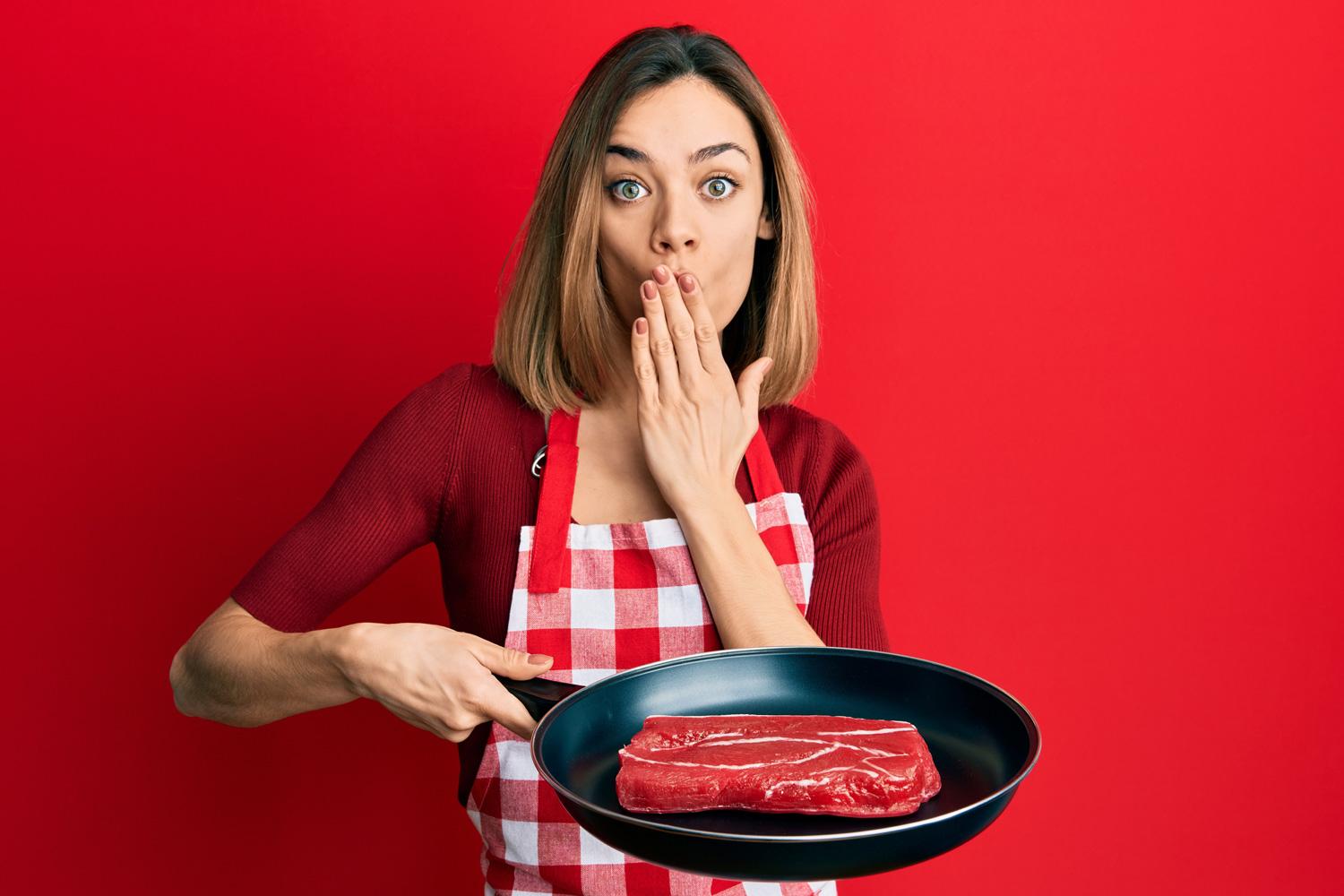
① Cooking at a high temperature for a short period of time is no bueno
You might think: “Oh, if I want a steak that’s medium rare, then I can just heat that pan up hot, cook the steak on high, then just lower the temperature in the end, and I’ll end up with a perfectly delicious steak in a short amount time! Shortening the cooking time means the juices won’t have time to escape.”
Well... Think again! The Meat Guy doesn’t really recommend this cooking method. Sure. You’ll get a steak in the end, but you risk overcooking it and ruining a perfectly good piece of meat. Plus, it’s very hard to control the degree to which your steak is cooked this way.
Also, cooking on high from the get-go will shrink the steak. And those juices that you thought won’t escape... Well, they’ll be squeezed out when the steak shrinks. You’ll end up with a dry and lifeless slab of meat that looks like this:

This just ain’t it. It might look delicious to some, but it’s not exactly what The Meat Guy is aiming for. A lot of people might even call that medium rare. But, it’s more like a mixture of well-done and rare, with just a touch of medium-rare.
So, then you might think: “so am I not supposed to use this cooking method anymore?!” Not quite. If you’re cooking a steak that’s up to 1cm thick, that’s actually the best cooking method to use!
② “Eat right after it’s cooked! Don’t waste the precious juices!” NOPE.
Who wouldn’t want to dig in right away after all that hard work?! The scent of a freshly cooked steak alone is enough to get your appetite going! We get it... but do your best to wait just a little bit more. If you cut into the steak right away, the juices will escape. It’s best to first wrap the steak in aluminum foil to keep it warm, and let it rest for the same time it was cooked.
Preparing to cook thick steaks

Steaks with a thickness of less than 1 cm can be cooked well in a short time, but if it is 1 cm or more, the heat might not pass through all the way to the center. Cooking a thick steak to your ideal doneness starts from the preparation stage. With that said, here are the important points to remember when preparing your steak!
●POINT ① THAWING

The best way to thaw meat without losing its flavor is to thaw it in ice water! A 1-pound ribeye steak can be thawed in about 12 hours using the following method.
1. First, put the unopened meat package in a thick plastic bag and place it in a bowl about twice as large as the meat. Even the unopened meat package may have small holes due to friction during the delivery process, so be careful not to let water seep through the plastic packaging.
2. Next, fill the bowl with ice and add water.
3. If the amount of ice in the bowl runs low, make sure to refill it.
Another great way to thaw meat is to let it thaw naturally in the refrigerator or chiller. It takes about two days to completely thaw in the refrigerator, so make sure to plan accordingly! The details for this thawing method are written in the article linked below, so make sure to check it out!
・DEFROST MEAT SO YOU DON’T RUIN IT!
https://www.themeatguy.jp/en/cookingstudio/recipe/56_thawing
●POINT ② MEAT TEMPERATURE
After all that waiting for the meat to thaw, you may just want to jump right in and cook it immediately afterwards... Hold on! If you cook the meat when it’s still cold, you risk ending up with unevenly cooked meat. The surface may end up burnt, while the center is still raw. Yuck! After taking it out of the fridge, let it rest at room temperature for about 10 minutes (or about 30 minutes if the room temp is low, like during winter.)
●POINT ③ CUT THE TENDON

If you "cut the tendons", you can prevent the meat from shrinking, and have a cleaner and softer finish in the end. Use the tip of a knife to cut along the tendons (the part between lean meat and fat.)
●POINT ④ SEASONING
We recommend seasoning with salt and pepper 10 to 30 minutes before cooking. By allowing a little time after seasoning, the salt on the surface of the meat will dissolve just right, so the salt will not be burnt during the cooking process.
Instead, it will seep into the meat! The amount of salt should be about 1% of the weight of the meat. Make sure to season both sides of the meat! The point is to apply it evenly on both sides of the meat, and to season when it’s thawed.
TIPS FOR COOKING THICK STEAKS
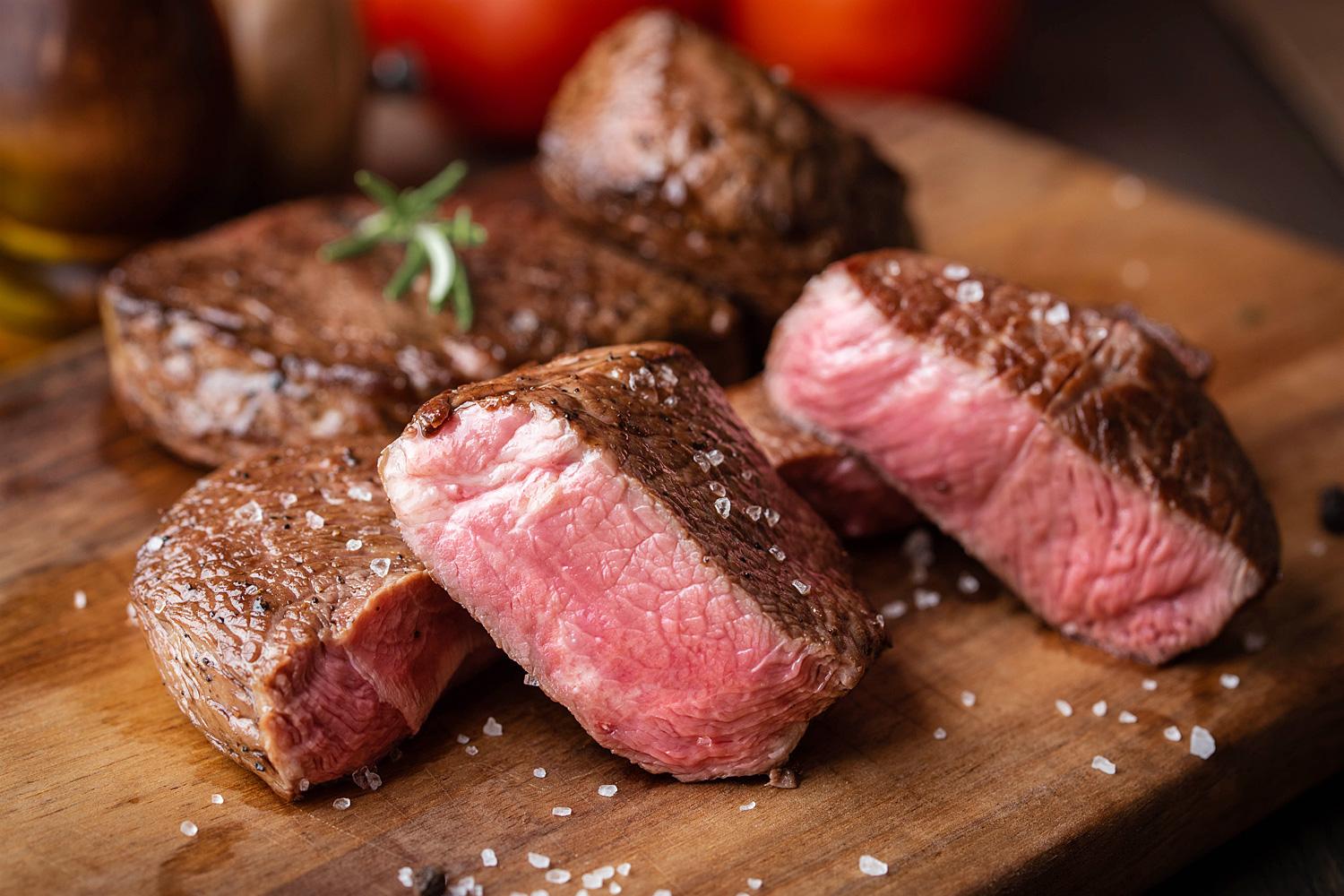
Once you've prepared it right, all you have to do is cook it! When cooking thick steaks, the most important point to remember is to "take your time, without suddenly cooking at a high temperature!"
The Meat Guy recommends cooking steaks to "medium rare." Here are 3 ways to cook thick steaks, so you can get that beautiful medium rare pink color. ♪
THE MEAT GUY’S TOP PICK! This is the real way to cook medium rare steaks

When using a frying pan, use the lowest heat setting to cook the steak. Also, using a pan that is a size bigger than the steak is recommended. If you’re using a grill to cook the steak, don’t place the meat directly on top of the fire. Shift it to a position where it’s not directly exposed to the fire.
After properly preparing your meat, lightly oil your frying pan with your favorite oil (salad oil, olive oil, beef tallow, etc.), and then cook the steak slowly over low heat. Cook for about 3-5 minutes on each side until the whole steak changes to a whitish hue. Move and adjust the meat position until the temperature eventually reaches about 52-53 ° C from room temperature.
Depending on the thickness of the steak and the heat source, it will take about 20 to 30 minutes to cook. At the very end, you can sear the surface with high heat to add color to the meat. You can even use a torch at this time if you want.
Searing the surface of the steak until it’s browned causes something called a “Maillard reaction”*1 (burning the proteins on the surface,) resulting in a more fragrant and aromatic steak!
When the steak is cooked, remove it from the heat and let the meat rest.

We recommend wrapping the steak in aluminum foil and letting it rest away from the heat. If you let it rest as is on the frying pan, the temperature will still rise from the residual heat. It is best to remove from the heat at 52-53 ° C and let the residual heat bring it up to 55 ° C. After that, the meat keeps a constant temperature and gradually cools down.

By letting it rest, you’re allowing the meat to relax a bit so it can give you the juiciest steak. The juices will stay in the meat, and won’t easily escape once you cut into it. This will result in more satisfaction with every bite!
The surface will be nice and browned, while the inside is evenly cooked. This is what a properly-cooked medium-rare steak should be!
*1 The Maillard reaction is a browning phenomenon caused by non-enzymatic browning. Sugars and amino acids react with each other to create a unique scent.
Relationship between Maillard reaction and deliciousness: When the sugars and amino acids contained in meat are heated and the Maillard reaction occurs, a very complex aroma is created. People have the illusion that food with a complex aroma is "delicious". Therefore, the steak that caused the Maillard reaction feels even more delicious!
AN EASIER WAY TO COOK THICK STEAKS
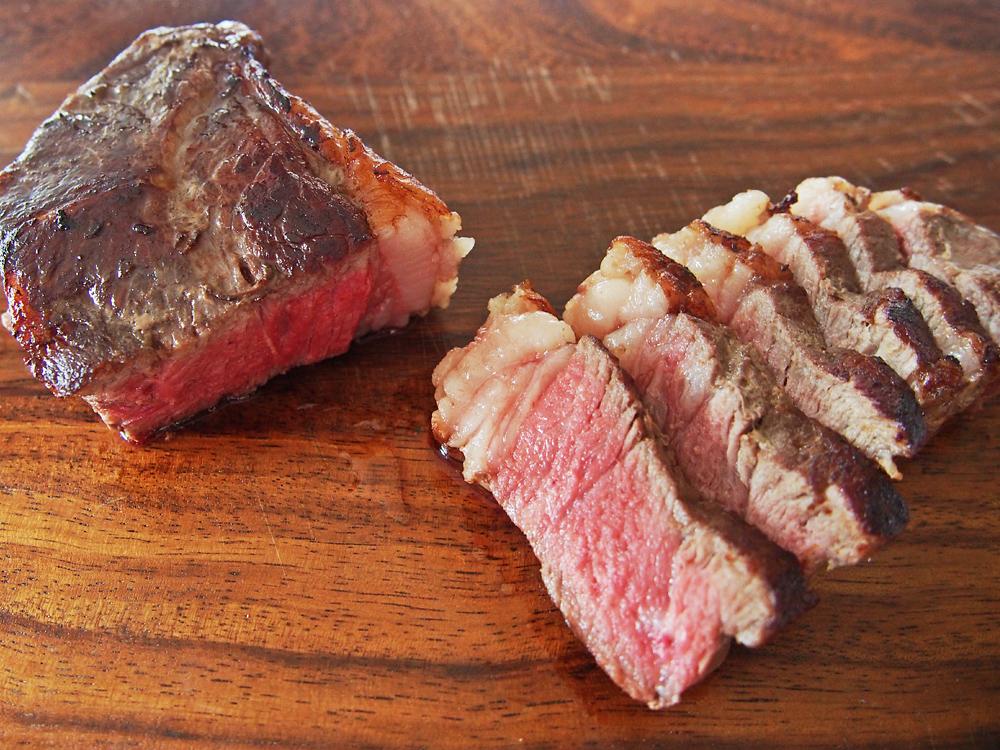
The best way to enjoy steaks is to cook it medium-rare. However, some might find that a bit too challenging. For those who aren’t as confident with their cooking skills, here’s an easier way to cook thick steaks!
First, heat a frying pan with a thin layer of your favorite oil (salad oil, olive oil, beef tallow, etc.) over medium heat. Next, add the prepared meat, place a lid on the pan, reduce the heat to low, and steam for 10 minutes. Flip it over and steam for another 10 minutes on low heat.
After steaming, take the meat out of the frying pan, wipe off the excess oils from the pan, coat the pan with a fresh layer of oil, then sear the surface of the meat over high heat. When it’s nice and brown, you’re done!
Finish it off by wrapping in aluminum foil and letting it rest, as in the case of medium rare. With this cooking method, you can let the meat rest for about 10 minutes.
With this method, there will be quite a bit of the juices that will flow out during the cooking process... If you don’t want to waste that, you can use it to make steak sauce using wine, soy sauce, and mirin.
COOK USING A LOW TEMPERATURE SLOW COOKER

With the help of this nifty little tool, you can easily cook thick steaks! By continuing to give the meat only the minimum required temperature, it is possible to kill the bacteria that live in the raw meat and make a safe, soft, and delicious steak.
If you want to cook 2cm thick beef at low temperature to a medium rare state (it is cooked but the cross section is pink when cut), you can heat it at 58°C for 2 hours! Even if the bacteria have invaded the inside of the meat, it is possible to reduce the number of bacteria to 1/10,000 or less. For roast cuts with a thickness of 5cm, heating at 58°C for 4 hours and 40 minutes is the standard.
Detailed recipes and usage are also introduced in the following article linked below, so please check it out!
・"SOUS VIDE" OR LOW TEMPERATURE SLOW COOKING BEGINNER'S GUIDE
https://www.themeatguy.jp/en/cookingstudio/recipe/19_boniq
We've shown you how to cook a thick steak, but please understand that it may take some time before you can master these techniques. Just do your best, and follow the directions. Of course, don’t forget to have fun with it too! Enjoy your delicious home-cooked thick steaks!
THE MEAT GUY'S RECOMMENDED PRODUCTS
-
-
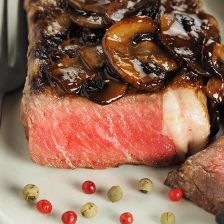 Grass-Fed Beef Striploin/Sirloin Steak 270g¥1,790 (txInc)The same cut as the Kansas City strip but from down under. Not as tender as the US steaks but plenty of flavor. (Frozen)
Grass-Fed Beef Striploin/Sirloin Steak 270g¥1,790 (txInc)The same cut as the Kansas City strip but from down under. Not as tender as the US steaks but plenty of flavor. (Frozen)
-
-
-
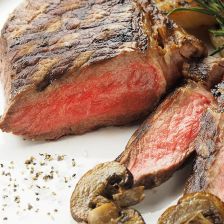 Grass-Fed Beef Ribeye Steak (270g)¥1,790 (txInc)One of the tastiest steaks and considered the king of many steakhouses as it has the most rich, bold flavor. (Frozen)
Grass-Fed Beef Ribeye Steak (270g)¥1,790 (txInc)One of the tastiest steaks and considered the king of many steakhouses as it has the most rich, bold flavor. (Frozen)
-
-
-
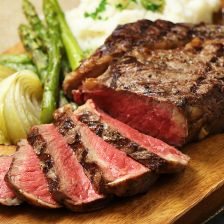 Grass-Fed Beef One Pound Ribeye Steak (Over 450g!)¥3,610 (txInc)Just when you thought our steaks couldn't get any bigger!
Grass-Fed Beef One Pound Ribeye Steak (Over 450g!)¥3,610 (txInc)Just when you thought our steaks couldn't get any bigger!
-
-
-
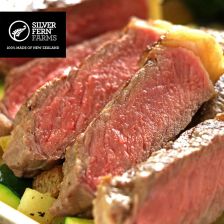 New Zealand Grass-Fed Beef Strip Steak(270g)¥2,790 (txInc)Grass fed striploin steak from New Zealand. (Frozen)
New Zealand Grass-Fed Beef Strip Steak(270g)¥2,790 (txInc)Grass fed striploin steak from New Zealand. (Frozen)
-
-
-
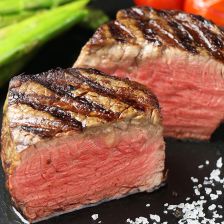 Grass-Fed Beef Filet Mignon (250g)¥3,290 (txInc)The premier steak cut also called the "Chateaubriand", but we don't call it that because we can't even pronounce it correctly! (Frozen)
Grass-Fed Beef Filet Mignon (250g)¥3,290 (txInc)The premier steak cut also called the "Chateaubriand", but we don't call it that because we can't even pronounce it correctly! (Frozen)
-
User Guide
Since 1997, we have been a meat mail-order shop! Introducing The Meat Guy's appeal and why customers continue to choose us.
Shipping is free for orders of ¥10,000 (including tax) or more to one delivery address.
We will show you the payment methods that you can use, such as credit card, cash on delivery, and bank transfer.
If you register as a member, you will earn 5 points for every 100 yen you order.
Our Store Uses SSL Encryption.


